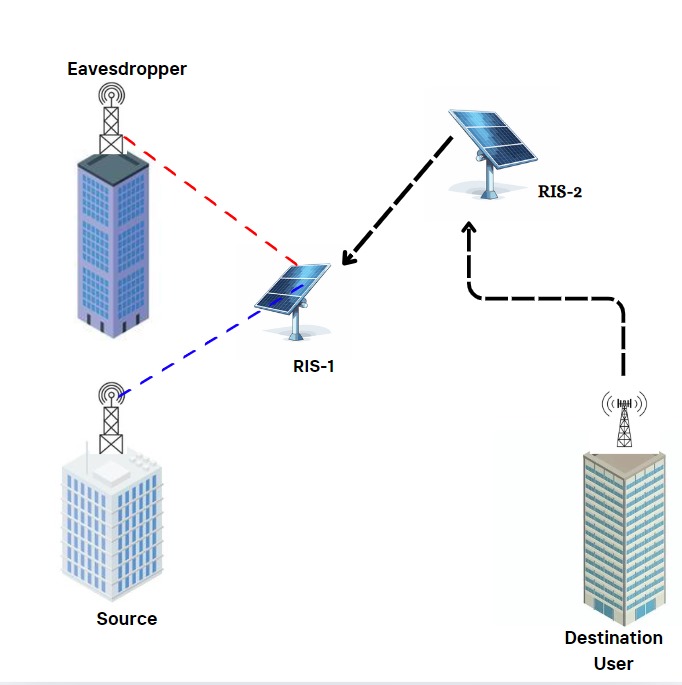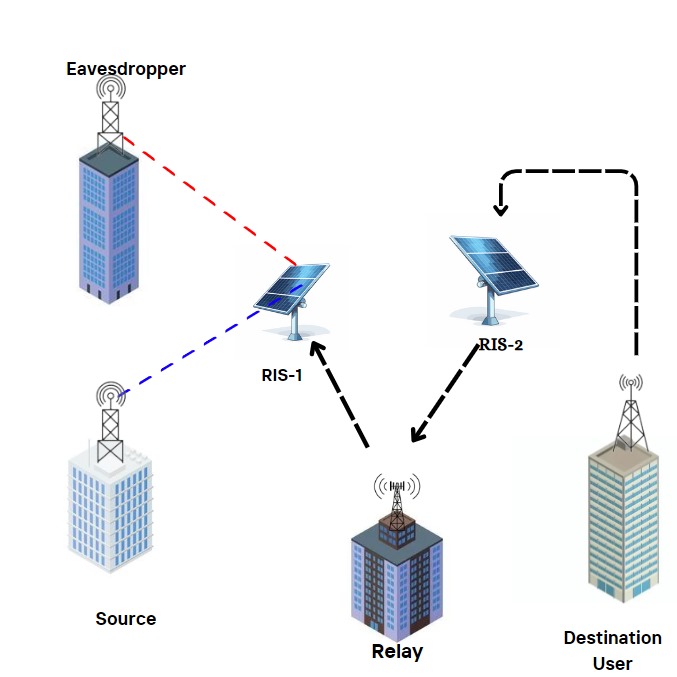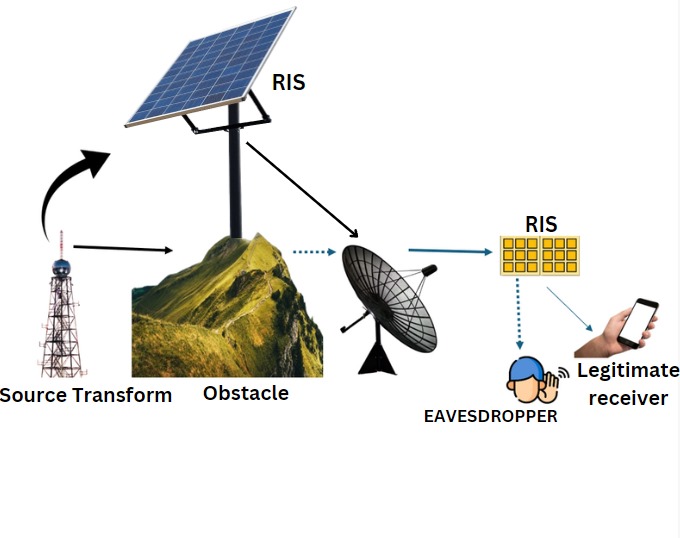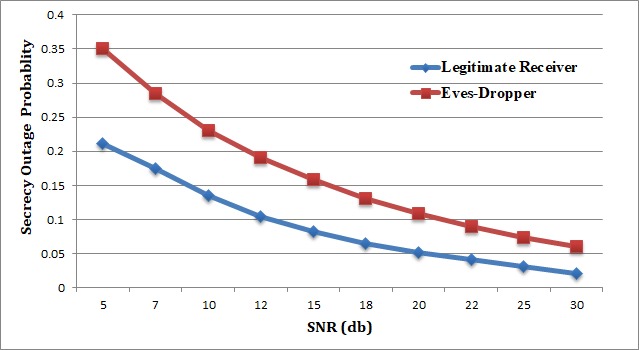Ijraset Journal For Research in Applied Science and Engineering Technology
- Home / Ijraset
- On This Page
- Abstract
- Introduction
- Conclusion
- References
- Copyright
Enhancing Secrecy Capacity Using Reconfigurable Intelligent Surfaces in Line-of-Sight (LOS) Scenarios for Beyond 5G Networks
Authors: Taha Shahzad , Muhammad Umer, Basit Ali, Muhammad Ibrahim Shaikh, Arslan Ajmal, Muhammad Zafir
DOI Link: https://doi.org/10.22214/ijraset.2025.66898
Certificate: View Certificate
Abstract
Physical Layer Security (PLS) is a promising approach for securing the Beyond 5G (B5G) wireless networks by exploiting the physical properties of communication channels. Reconfigurable Intelligent Surfaces (RIS) are used to enhance PLS by dynamically controlling signal reflections to favor the legitimate users while degrading eavesdropper channels. This paper focuses on using RIS to improve the secrecy capacity in Line-of-Sight (LOS) scenarios. Through our theoretical analysis, we demonstrate that RIS can effectively strengthen secure links and mitigate the interception risks, while offering a practical and energy-efficient solution for secure B5G communications.
Introduction
I. INTRODUCTION
Secure and lossless transmission of data are the essential goals in B5G/6G networks. As B5G/6G Networks are expanding in more densely populated areas, the exchange of information needs to be instantaneous and prone to all transmission limitations and security risks involving third-party intruders such as eavesdroppers.
Physical layer Security (PLS) has been able to achieve privacy in communication by its ability to randomize the wireless communication between the two intended parties [1].
Line of Sight (LoS) communications is a type of propagation where the data transmission occurs where the sender and receiver are at direct visibility of each other without any obstacles in between [2]. The use of PLS and LoS has made secure, low latency data transmission possible and has become crucial aspect of B5G/6G networks. In contrast, the expansion of these networks in urban and high-density areas restricts the use of LoS due to its limitations [2]. This paper intends to conduct a theoretical analysis to mitigate security and propagation constraints to achieve this.
Reconfigurable intelligent surfaces (RIS) are an emerging technology in the domain of wireless communication technology capable of altering the propagation environment into any desired form [3] [4]. The RIS consists of many elements that use their reflecting capabilities to dynamically tune its electromagnetic (EM) response through on-board positive-intrinsic-negative (PIN) diodes [5]. RIS has emerged as a major technology in wireless systems due to its ability to improve signal quality while not harnessing any extra energy sources [6].
While existing work covers the performance of PLS while using RIS, and the two technologies individually, it is interesting to study the implementation of secure LoS communication using RIS, for wireless transmission in densely populated areas where there are transmission constraints due to the buildings and obstacles, and the increasing risk of third-party intrusion.
In this work, we study the achievable solution for B5G/6G users in these areas to use secure LoS communication by using RIS. More specifically, we assume an environment where RIS are used first, alter the main link between the two wide-area networks (WANs) and then, used again in the receiving WAN to transmit data to the intended user using varying frequency to differentiate between the intended receiver (the end user) and the eavesdropper (third-party intruders).
The rest of this paper is organized as follows. Section II reviews the relevant work in the field. Section III describes the proposed approach in detail, and Section IV gives the results and discussion. In Section V Finally, the paper is concluded with insights on future research directions.
II. RELATED WORK

Fig. 1. Signal Transmission Through Multiple RIS

Fig. 2. Signal Transmission Through Relay and RIS
RISs are distinct because they do not require a power supply, signal processing, or encoding and decoding functions but instead passively reflect signals to improve communication. In Fig. 1, two RIS are used to transfer signal but due to absence of relay there will be path loss as well as signal-to-noise ratio (SNR) reduction, but this can be used if relay is not present and the energy efficiency is to be increased. While in Fig. 2, a relay is used which reduces path loss and SNR is stabilized.
In early studies, [7] first highlighted the use of RISs to improve wireless communication by passive beamforming. Their work showed that RISs could effectively steer wireless signals towards intended users, significantly boosting system performance by enhancing the (SNR) without adding complex transmission power. Moreover, [8] extended this idea by demonstrating the use of RISs in multi-user scenarios to maximize capacity, illustrating the ability to control the environment and thus adjust signal transmission dynamically.
In contrast to traditional relaying methods, which require power amplification or signal decoding and forwarding, RISs passively adjust the phase shifts of the reflected signals to enhance reception. [9] compared RISs with relaying systems, focusing on the power consumption and spectrum efficiency of RISs versus traditional relays. They showed that RISs could achieve similar coverage improvements as relays but without the power and complexity costs associated with active relaying.
Coverage analysis in RIS-aided systems has been an area of interest but largely under-explored. Early works focused primarily on the theoretical aspects of RIS deployment in ideal settings, where the main benefit was attributed to the increased coverage area without significantly altering the network's architecture. For instance, [10] analyzed the coverage of RIS in a cellular network and found that with proper phase-shifting optimization, RISs could significantly improve coverage in urban areas with severe path loss. However, despite the widespread consensus on RIS's potential, [11] are among the first to explicitly derive a quantitative coverage analysis, comparing RIS-aided communication with relaying systems and direct-link transmissions.
In terms of SNR gain, the Probability of SNR Gain (PSG) metric has been an essential tool for comparing the performance of RISs with traditional systems. [12] analyzed the SNR gain achievable by relaying systems, especially focusing on the performance loss in multi-input, multi-output (MIMO) systems. In their study, they identified that MIMO relay systems could achieve SNR gains even when the diversity order was lower than that of single-hop systems. Similarly, in RIS-based systems, the SNR gain depends on the system parameters such as the path loss exponent, the number of reflecting elements, and the configuration of the reflecting meta-surfaces.
Further studies by [13] introduced a generalized model to quantify the SNR gain in RIS-aided systems and compared it with direct-link transmissions and relays. Their findings corroborated earlier results showing that RISs provide significant SNR improvements, especially in challenging environments with high path loss. This is primarily due to the phase-shifting capabilities of RISs, which can optimize the propagation path to mitigate signal degradation. Their approach demonstrated how RISs could outperform traditional systems by providing larger coverage and higher SNR without the need for power-hungry equipment.
For delay outage rate (DOR) analysis, which is crucial for ultra-reliable low-latency communications (URLLC), [14] proposed a method to compute the delay outage in RIS-aided systems. They showed that the ability of RISs to focus signals effectively could reduce the overall delay and improve system reliability, particularly in applications requiring low latency. This is consistent with earlier works where relays were shown to reduce delays, but RISs achieve this without the need for active processing or power amplification, thus improving energy efficiency.
One major contribution of [11] is the extension of coverage, PSG, and DOR analysis specifically for RIS-aided communication systems. The authors presented the performance of RISs in terms of coverage, comparing it with both relay-based and direct-link systems. This work fills a gap in the literature by introducing quantitative models for both coverage and delay outage analysis in RIS networks. The findings in this study highlight that the use of RIS can not only expand coverage but also increase the SNR and reduce latency, making it a powerful tool for future communication systems.
In summary, RIS-aided systems have received considerable attention in recent years. While early work focused on the theoretical aspects and benefits of RISs, subsequent studies have made significant progress in analyzing performance metrics like coverage, SNR gain, and delay outage rate. This body of work has established RISs as a promising technology for enhancing future wireless communication systems. The work of [5] marks a significant step forward in providing quantitative analysis for these metrics, demonstrating the potential of RISs to improve communication networks in terms of coverage, SNR, and reliability.
III. PROPOSED APPROACH
The proposed approach of (RIS) is to dynamically manipulate wireless signals to improve communication performance, especially in environments where traditional Line-of-Sight (LOS) is obstructed.
First of all problem statements of (RIS) have high-frequency signals (e.g., millimeter waves in 5G/6G) and provide high data rates but suffer from poor penetration through obstacles (e.g., walls or buildings). Blockages in LOS severely degrade the signal quality, reducing communication efficiency. While existing solutions, like deploying additional base stations or relays, are costly and also energy-intensive.
As move forward we have proposed solution of RIS which provides an energy-efficient and cost-effective alternative by introducing programmable reflective surfaces on the existing obstacles as shown in Fig. 3, enabling enhanced signal propagation without needing any additional active hardware. Some key steps that we have in the Approach of Reconfigurable Intelligent Surfaces these are RIS are deployed on strategic locations, such as Building walls, Glass windows, Street furniture (e.g., lampposts or billboards). These surfaces are positioned to intercept signals from the transmitter. When signals from a transmitter hit the RIS reflection/refraction the surface reflects or refracts the signal toward the receiver.
Beamforming RIS dynamically adjusts its reflective elements to focus the signal directly at the legitimate receiver. Phase Alignment: By controlling the signal phase, RIS ensures constructive interference, improving signal strength at the receiver. RIS behavior is controlled by a central controller or base station, which uses Channel State Information (CSI) real-time data about signal conditions and obstacles. Optimization Algorithms it determine the best configuration of the RIS to maximize performance (e.g., throughput, signal-to-noise ratio). RIS can selectively direct the signals toward legitimate users, reducing the risk of signal interception by any unauthorized eavesdroppers.
RIS gives us transformative potential in wireless communication by enhancing coverage, efficiency, and security with the minimal energy consumption. As passive devices which require little to no power, RIS are the cost-effective alternatives to the traditional infrastructure like additional base stations or active relays, significantly improving energy efficiency of system. As RIS uses adaptive beamforming and phase alignment capabilities optimize signal propagation, overcoming obstacles and reducing dead zones, especially in high-frequency 5G/6G networks. Furthermore, in the proposed approach we are using RIS to enhance security by dynamically directing the signals to legitimate users, mitigating eavesdropping risks. These attributes make RIS highly applicable in the urban and indoor scenarios, ensuring robust connectivity even in dense environments and enhancing the performance of (IoT) systems, Vehicle-to-Everything (V2X) communication, and smart infrastructure.

Fig. 3. Proposed RIS model for LOS scenarios
By leveraging RIS, wireless systems achieve their seamless, secure, and scalable communication tailored to dynamic real world scenarios. By intelligently using RIS, the proposed approach aims to make wireless communication more efficient, secure, and robust, particularly in any given high-frequency scenarios where our traditional systems fall short.
In RIS we enhance wireless security by reducing signal strength in unintended directions, effectively preventing eavesdropping. By leveraging real-time (CSI), RIS dynamically adjusts the phase as well as the amplitude of reflected signals to create destructive interference in the regions where eavesdroppers may be located. It ensures that the signal power is concentrated mainly on the intended receiver, minimizing its leakage elsewhere. Unlike conventional methods such as widely used active jamming technique , this passive and energy efficient approach enhances physical layer security without introducing any additional interference, making it ideal for high-frequency communication systems like the 5G and 6G.
IV. RESULTS AND ANALYSIS
This section presents the results based on the comparison, for determining how our proposed approach can enhance the secrecy capacity of legitimate receiver (LR) over the eavesdropper (Eve). We have compared the secrecy outage probabilities of a LR and an Eve in a wireless communication system using our proposed approach. Our analysis considered various (SNR) values, ranging from about 5 dB to 30 dB, and assumed a path loss exponent of 0.5, noise variance of 1, and transmits power of 1 unit as mentioned in Table. I.
|
Parameters [Proposed work] |
Legitimate receiver (LR) [Proposed work] |
Eavesdropper (Eve) [Proposed work] |
|
Distance [units] |
1 unit |
2 units |
|
Path loss exponent |
0.5 |
0.5 |
|
Noise variance
|
1 |
1 |
|
Transmit power [unit] |
1 unit |
1 unit |
TABLE I. Stimulation values for getting Secrecy Outage Probability
The results, based on stimulation in Fig. 4 demonstrate the secrecy outage probabilities of legitimate receiver and eavesdropper at each SNR value, revealing a significant performance gap between both of them. Specifically, with our approach legitimate receiver consistently outperforms eavesdropper, with lower secrecy outage probabilities across all SNR values.
The stimulation of our approach in Fig. 4 shows a decreasing trend in secrecy outage probability for both legitimate receiver and eavesdropper as the SNR increases. We can analyze that, the performance gap between legitimate user and eavesdropper widens as the SNR increases from 5 dB to 30 dB as in Table. II, underscoring importance of optimizing the system parameters to ensure secure communication. These findings provide valuable insights into the design of secure wireless communication systems, highlighting the need for careful consideration of distance, path loss, and noise variance. Results of our approach contribute to the development of efficient and secure communication protocols, enhancing the reliability and confidentiality of wireless transmission.
|
SNR (dB)
[Proposed work] |
LR Secrecy Outage Probability
[Proposed work] |
Eve Secrecy Outage Probability
[Proposed work] |
Performance Gap (%)
[Proposed work] |
|
5 |
0.2111 |
0.3512 |
66.5% |
|
10 |
0.1351 |
0.2311 |
70.5% |
|
15 |
0.0821 |
0.1581 |
92.5% |
|
20 |
0.0511 |
0.1081 |
111.5% |
|
25 |
0.0311 |
0.0741 |
138.3% |
|
30 |
0.0211 |
0.0611 |
190.0% |
TABLE II. Performance gap comparison at different SNR values

Fig. 4. Secrecy Outage Probability comparison between LR and Eve
Conclusion
In this paper we analyzed how to utilize reconfigurable intelligent surfaces (RIS) to enhance the secrecy capacity of LOS scenarios for beyond 5G networks. An analysis of the secrecy outage probability of both legitimate receiver (LR) and eavesdropper (Eve) demonstrates that, under all SNR values, LR performed better than Eve, with the performance gap further amplified at higher SNR, these results emphasize the need to optimize system parameters, such as placement and configuration of RIS, to improve security and reliability. Future research could explore integrating RIS with advanced technologies like machine learning and artificial intelligence to optimize system adaptability and performance in dynamic environments. Additionally, studying RIS-aided security in non-line-of-sight (NLOS) scenarios, incorporating mobility, and addressing challenges posed by multi-user and interference-limited settings could further enhance the practicality of RIS in next-generation wireless networks.
References
[1] J. D. V. Sánchez, L. Urquiza-Aguiar, M. C. P. Paredes, and D. P. M. Osorio, “Survey On Physical Layer Security For 5G Wireless Networks,” Ann. Telecommun., vol. 76, no. 3, pp. 155–174, 2021. [2] G Gemmi , R Lo Cigno and L. Maccari , “On Cost-Effective, Reliable Coverage for LoS Communications in Urban Areas” IEEE Transactions On Network And Service Management, Vol. 19, No. 3, September 2021. [3] M. H. Khoshafa, T. M. N. Ngatched and M. H. Ahmed, \"RIS-Aided Physical Layer Security Improvement in Underlay Cognitive Radio Networks,\" in IEEE Systems Journal, vol. 17, no. 4, pp. 6437-6448, Dec. 2023. [4] E. Björnson and P. Ramezani, \"Maximum Likelihood Channel Estimation for RIS-Aided Communications with LOS Channels,\" 2022 56th Asilomar Conference on Signals, Systems, and Computers, Pacific Grove, CA, USA, 2022, pp. 403-407 [5] M. Rüb, J. Grüber, C. Lipps and H. D. Schotten, \"Update Rate and Dimension Requirements for Reconfigurable Mirror Arrays in Vehicular Visible Light Communication,\" 2024 IEEE 99th Vehicular Technology Conference (VTC2024-Spring), Singapore, 2024, pp. 1-6, [6] Liang Yang, Jinxia Yang, Wenw Xie, Mazen O Hasna, Theodoros Tsiftsis, et al.. ‘’Secrecy Performance Analysis of RIS-Aided Wireless Communication Systems’’. IEEE Transactions on Vehicular Technology, 2020, ff10.1109/TVT.2020.3007521f [7] E. Basar, M. Di Renzo, J. De Rosny, M. Debbah, M. Alouini and R. Zhang, \"Wireless Communications Through Reconfigurable Intelligent Surfaces,\" IEEE Access, vol. 7, pp. 116753-116773, 2019. [8] Q. Wu, and R. Zhang, “Towards smart and reconfigurable environment: Intelligent reflecting surface aided wireless network,” IEEE Commun. Mag., vol. 58, no. 1, pp. 106-112, Jan. 2020. [9] M. Morsi, S. K. Das, and K. Yang, \"Coverage Analysis of Reconfigurable Intelligent Surfaces in Cellular Networks,\" IEEE Trans. Commun., vol. 68, no. 5, pp. 2895-2908, May 2020. [10] Z. Yang, L. Zhang, and S. Chen, \"Quantitative Coverage and Delay Outage Rate Analysis for RIS-Aided Communication Systems,\" IEEE Trans. Wireless Commun., vol. 69, no. 8, pp. 4891-4905, Aug. 2020. [11] M. Alouini, M. Di Renzo, and E. Basar, \"On the SNR Gain of RIS in MIMO Systems,\" IEEE J. Sel. Areas Commun., vol. 37, no. 8, pp. 1916-1926, Aug. 2019. [12] X. Li, X. Li, and R. Zhang, \"Generalized SNR Gain Modeling for RIS-Aided Wireless Networks,\" IEEE Trans. Signal Process., vol. 68, pp. 4516-4529, Nov. 2020. [13] J. Zhao, Y. Chen, and X. Zhang, \"Delay Outage Rate and Performance Analysis of RIS-Aided Networks for URLLC,\" IEEE Access, vol. 8, pp. 89111-89122, 2020. [14] Z. Ding, Y. Zhang, and Q. Wu, \"Practical Implementation of Reconfigurable Intelligent Surfaces in Wireless Networks: Challenges and Solutions,\" IEEE Trans. Commun., vol. 69, no. 4, pp. 2375-2387, Apr. 2021.
Copyright
Copyright © 2025 Taha Shahzad , Muhammad Umer, Basit Ali, Muhammad Ibrahim Shaikh, Arslan Ajmal, Muhammad Zafir. This is an open access article distributed under the Creative Commons Attribution License, which permits unrestricted use, distribution, and reproduction in any medium, provided the original work is properly cited.

Download Paper
Paper Id : IJRASET66898
Publish Date : 2025-02-10
ISSN : 2321-9653
Publisher Name : IJRASET
DOI Link : Click Here
 Submit Paper Online
Submit Paper Online

